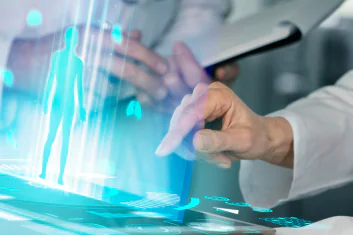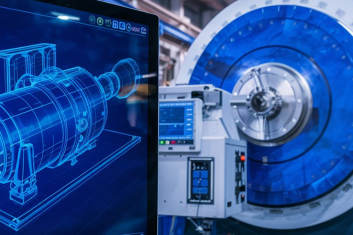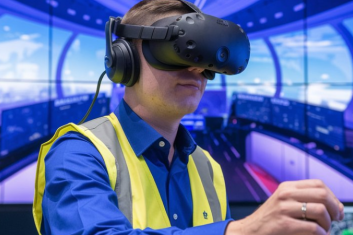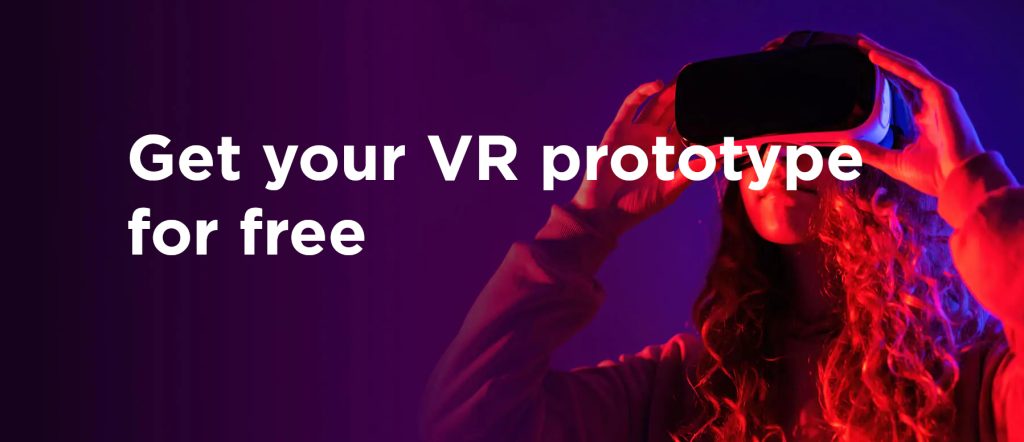What is Mixed Reality in Education
It certainly doesn’t come as a surprise that remote education is becoming more and more popular. Education market growth rates exceed analytical forecasts.
In a constantly evolving world, education should evolve even faster. And that’s exactly why Mixed Reality and AR/VR development are so popular in this field in education as a new learning tools – they revolutionize the way students and employees can learn and acquire new skills or polish existing ones.
In this article we will examine:
- what MR in education is and how it works,
- when it is better to use MR than traditional methods of education, and
- the future prospects for Mixed Reality solutions in the education industry.
What is Mixed Reality in Education
Let’s start with the term itself.
Mixed Reality is a combination of real and virtual worlds achieved with the help of immersive technologies such as Augmented and Virtual Reality and real-world objects. This creates new environments and visualizations that incorporate physical and digital objects so that users can interact with them equally.
Back in 1994, when the term was first introduced, Mixed Reality was perceived as a concept of “virtuality continuum and the taxonomy of visual displays.” Now, of course, it has gone far beyond displays, and includes the following as well:
- Understanding of surroundings, with the help of spatial mapping and anchors.
- Tracking of human features: gestures, eye movement, etc.
- Spatial sound.
- Positioning of objects in physical and virtual spaces.
- Collaboration on 3D content in virtual spaces.
To put it simply, in Mixed Reality, users can experience both real and digital content and take advantage of all the benefits of both.
The benefits of Mixed Reality shine the brightest in the education industry.
Yuri Yarmolovich
AR/VR Expert
at HQSoftwareMixed Reality allows students to interact and coexist within simulations that are blended with the real world. The most effective way to learn something is to put yourself inside a relevant experience and actually do something — and this is exactly what Mixed Reality solutions offer.
The main benefits of VR education and MR solutions are:
- Situated learning. With MR, students participate in experienсe-based learning and expand their knowledge by experiencing simulations with a realistic context.
- Reduced cognitive load. Students directly visualize, manipulate, and interact with complex structures and objects virtually.
- Improved test scores. According to Microsoft Education, there is a 22% improvement in test scores among students who prefer immersive learning over traditional educational methods.
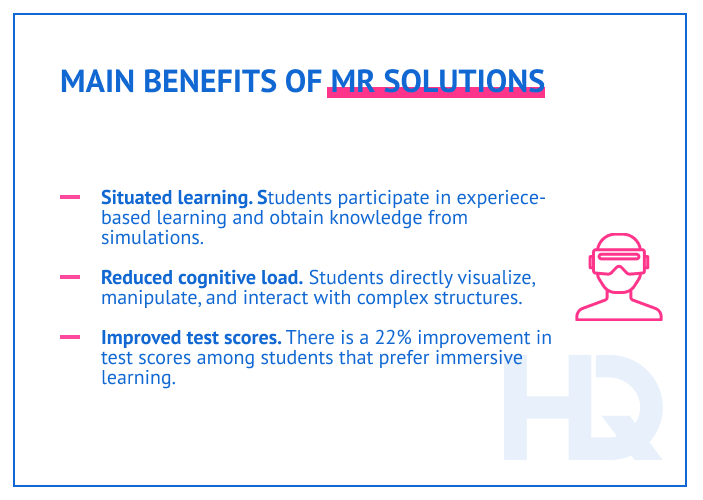
In addition, there is a 35% increase in student engagement and retention when using VR in the classroom or other immersive technologies.
Mixed Reality solutions, including Augmented Reality apps for education, also greatly expand the range of experiences available to students. It is possible to create a simulation of any possible learning scenario, whether that involves communication skills for oncologists or well drilling for engineers.
Mixed Reality also comes in handy when it’s impossible or difficult to expose students to real-life education. Sometimes it’s too dangerous or simply expensive to teach offline, and virtual experiences fill in the gap.
Imagine how much easier and cheaper it is to teach a surgeon in the virtual space than offline. The cost of becoming a surgeon in 2018 in the US was around $250,000 to $500,000. Mixed Reality solutions can cut training costs in half or even better.
And if you’re still not convinced that Mixed Reality learning is the future of the education industry, consider that the MR market has shown a steady increase since 2017 and is expected to reach $3.7 billion by 2025.
Let’s get straight to the point: when and where exactly are businesses using AR and VR to provide Mixed Reality learning to students?
When to Use AR and VR in Education
Mixed Reality educational solutions, as well as separate VR and Augmented Reality apps for education, are being used to solve various problems or enhance the conditions for learning. Let’s look at some situations when MR solutions are being used in various types of training.
To enhance the safety of training
Sometimes students are exposed to dangerous and even life-threatening situations before they’ve learned how to keep themselves safe.
For example, trainees risk being hurt while learning how to manipulate dangerous or heavy machinery. This may happen as a result of being around energized equipment, electrical appliances, industrial trucks, and so on.
According to the US Bureau of Labor Statistics, as of November 2020, 2.8 of every 100 workers had suffered an injury in the workplace. To reduce that percentage, it’s important for workers to undergo proper training in safe conditions.
Along with this, businesses need to be concerned about the possibility of having equipment damaged during training sessions and incurring high repair costs.
With Augmented Reality in education and Mixed Reality solutions, workers can safely:
- Gain practical skills;
- Learn how to respond in stressful and life-threatening situations;
- Learn how to safely manipulate dangerous equipment;
- Fail and try again as many times as it takes to develop a skill — all in a safe virtual environment.
As a result, we have a win-win situation: workers are well-trained and safe from injuries, and no equipment is damaged.
To promote effective learning
Learning by doing is proven to be the most effective way to learn not only practical skills but also soft skills.
Thanks to AR and VR education solutions, it is possible to develop a simulation of almost any process, from well drilling to talking sensitively to patients at their appointments.
Studies show that training via VR in the classroom has a 75% retention rate. Compare that to retention of information gained from lecture-based learning and reading — 5% and 10% respectively. The difference is outstanding!
For example, solutions for occupational training like one we developed at HQSoftware allow thousands of people around the world to find new jobs. They choose what skills they want to gain and start practicing in a relevant simulation.
Simulations allow for users to practice and work out how to do various skills, just as they would have done in reality.
How do modern businesses use AR to increase their revenues and outperform their industry competitors?
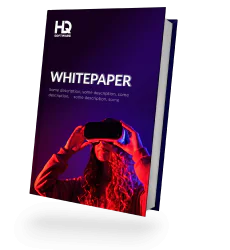
To make training engaging
Just looking at retention rates makes it clear that Mixed Reality training boasts impressive engagement as well. That’s an important marker of training effectiveness.
Students who prefer training and education in Mixed Reality report that they are much more engaged in the process compared to when they were using books, lectures, and other traditional educational models. Engagement is enhanced by personalization of content, immersiveness of simulations, and interactive features.
To ensure efficient knowledge processing
Because MR learning boosts student engagement and knowledge retention, it’s clear that it’s also efficient at boosting knowledge processing.
For example, take a look at this study of soft-skills training by PwC. Student results were impressive; they learned four times faster using VR than via traditional types of training.
Other features that affect learning efficiency are the ability to track and analyze one’s progress, provide and receive timely feedback, and personalize educational plans accordingly.
With Virtual Reality in education, all of these objectives can be fulfilled, thanks to the Tin CanAPI, a modern specification for learning solutions that can capture data about an individual student’s activities. Analyzing that data allows for enhancing the learning program to fit the student’s specific needs and track their performance automatically.
Want to create an AR/VR solution for your next corporate event? We’re ready to help!HQSoftware has a team of skilled professionals ready to tackle the project. Let’s talk!
Anna Halias
Business Development Manager
To promote a cost-effective approach to education
Traditional training is typically expensive, as it includes a ton of organizational steps, pre-training activities, and so on. For example, planning a traditional education includes:
- Initial briefing about the program;
- Choosing which method to use for delivering training content: in-person training, group classes, video tutorials, etc;
- Paying for staff time, including replacement time for workers busy with teaching;
- Instructor fees;
- Extra expenses including catering, travel, etc;
- Post-educational support and ongoing training.
With Mixed Reality training, these costs can be cut by as much as half.
Once you develop a training solution with reusable content, you won’t have to bear the cost of instructor fees or travel. All students will be able to access educational content remotely, and there will be no need to take staff away from their work to do training, or other extra expenses.
With all these benefits at hand, a growing number of businesses are actively researching and applying MR technologies to their educational and training projects.
Let’s take a look at some industries that have already applied MR to successfully educate their staff.
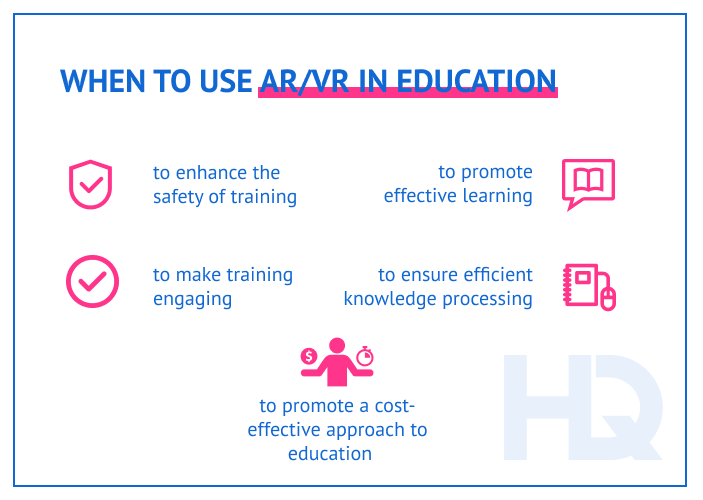
Industries already taking advantage of Mixed Reality in education
These industries use immersive technologies for education extensively:
Healthcare. In this industry, simulations are used for education across multiple fields. Surgeons practice on virtual patients, therapists learn how to talk about cancer, patients learn about the state of their body and a diagnosis interactively, so as to reduce anxiety.
Manufacturing. Engineers and field workers learn how to manipulate and fix industrial equipment, and how to respond in dangerous situations in the manufacturing process.
Automotive. Manufacturers actively apply Augmented Reality in education to build advanced HUDs that can help new and learning drivers on the road. Also, AR is used to build manuals and tutorials to train users in car repairs and maintenance.
Retail. Large companies such as Walmart use VR solutions to train employees, for example in using cash registers, and teach them how to interact with customers appropriately.
Finally, educational facilities. Since the world went remote because of the pandemic, many educational facilities have started to use Mixed Reality solutions to run classes in simulations, at least in part.
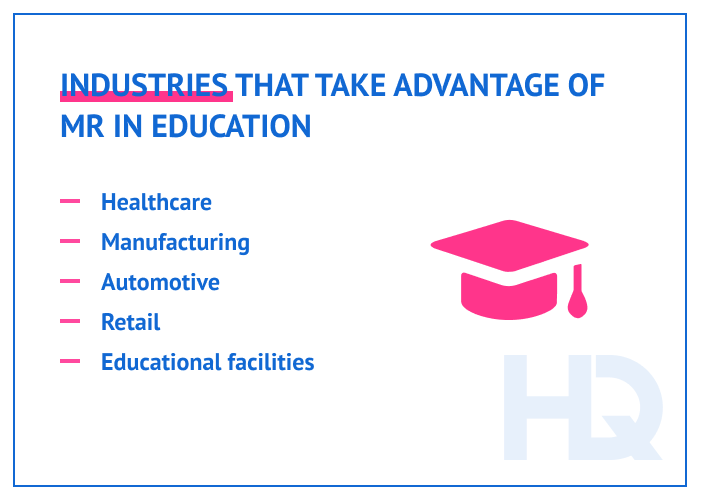
Now let’s see whether AR and VR differ in terms of applying them to educational processes, and when it is better to use either of them.
VR vs AR – when to use
We will start from the most influential factor – hardware requirements.
It is way easier and cheaper to build an AR educational solution. Often, everything you need here is a smartphone to run an application and that’s it – students have mobile and affordable access to education.
This is a suitable approach when the learning process does not require a high level of engagement and immersiveness and when there is no need to build a whole simulation. For example, children use AR apps to learn about nature and fauna by exploring interactive models of animals in AR.
On the other hand, we have VR solutions that require a certain amount of hardware to run. If we are talking about fully-immersive VR training, it requires a headset, either standalone or tethered. For tethered headsets, we need a computer as well.
VR training is more expensive and demanding, but it offers more opportunities. If the training required obtaining a complex skill or requires some practice then VR is the only choice. For example, practicing how to use heavy machinery or perform surgeries requires being immersed in the process, which is only available in VR.
Then let’s talk about entry barriers for both of these technologies.
With AR, teachers can easily support educational materials with animated 3D content to explain various concepts to students. AR comes in handy when students struggle with imagining volumetric objects, like algebraic ones.
With even a small amount of available AR experienced students and teachers can still enjoy a good complement to their learning process, and even replace some parts of traditional education processes.
With VR, this process is a little bit complicated. It’s not that easy to hop in and start using VR solutions unless the classroom or other educational space is equipped with a set of headsets, or students already have their own.
Also, getting acquainted with VR technology takes some time for students, but offers a lot more possibilities. This type of immersive education is suitable when students and teachers are required and ready to spend some time getting ready to use VR and are more dedicated to the long learning process.
In simple words, AR can help to catalyze the use of Mixed Reality technologies in the education for an unprepared audience and even children. It’s a perfect match for those who already have a well-balanced learning course and want to enhance it with modern technologies and approaches.
VR is a more demanding yet profitable choice. In a long run, building a VR learning solution will save a lot of money and time while providing students with unparalleled experience and education options.
Mixed Reality education solutions definitely have a great future ahead of them. Let’s review the most promising trends for Augmented Reality and Virtual Reality in education.
Prospects for AR and VR in Education
Let’s start with some stats.
The global market for VR in education is expected to reach more than $13 billion by 2026. Take a look at 2018 for comparison, when the market size was just $657 million.
For AR, the global education market reached $1.5 billion in 2020 and it’s still growing. In 2031 it is expected to reach up to $85 billion.
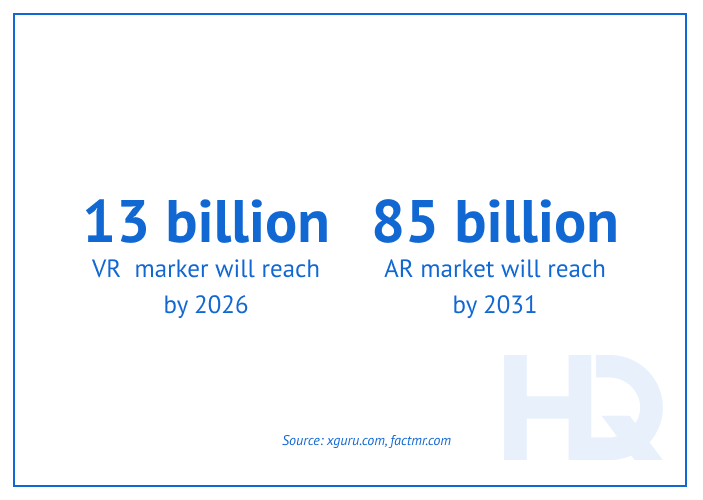
There are good reasons for such popularity and outstanding economic growth. MR solutions will change education forever.
Increased student focus
AR and VR learning solutions not only improve average students’ focus during learning sessions but can especially help those who have ADHD.
Interviewed students state that they have trouble focusing on learning materials — for some, it takes reviewing it time after time to pick up information because it’s difficult for them to maintain their attention.
The number of schoolchildren diagnosed with ADHD rises from year to year, and succeeding with traditional education is a burden for many.
Luckily, many educational facilities are now incorporating Mixed Reality solutions, which help students concentrate on the topic by bringing educational content right before their eyes without external distractions.
Learning with immersive technologies also includes using engaging and interactive methods, such as gamification.
No language or distance barriers
In today’s multicultural societies, having to deal with a language barrier seems outdated. That’s why it is so convenient to use AR and VR educational solutions — immersive tech can eliminate language barriers.
Educational content can easily be translated to multiple languages at once, and then students from all over the world can take the same course delivered in their native language.
This feature also contributes to the ideal of making a decent education available to everyone, no matter their origin, background, or social status.
Improved learning through an easier process
Organizing learning with the help of Mixed Reality solutions is much easier than organizing traditional education, but that doesn’t mean that the quality of education needs to suffer.
When immersive education becomes a new standard in learning, these are benefits for the whole system:
- Increased engagement and student focus;
- Ease of access to education;
- Better learning retention;
- Easier tools for performance tracking.
The learning process becomes easier and more efficient:
- Educational content is reusable and easy to complement and revise;
- Costs are lower, especially for student and teacher travel, accommodation, etc;
- Tools for learning are safer and more interactive;
- Students have the opportunity to learn at their own pace at no extra expense for the learning provider.
To sum up, these factors mean a bright future for AR and VR in the education field in coming years. With Mixed Reality, education will become cheaper, easier, and more accessible, interactive, and efficient.
More and more companies in various fields will turn to MR solutions to make staff education better and contribute to providing safer and more efficient tools for employee training. Companies in fields ranging from healthcare to manufacturing, retail, and other industries will increasingly choose MR over traditional education.
If you are representing such a company, drop us a line. We’ll be happy to show you how you can apply Mixed Reality solutions in education to fit your business needs.

Head of Production
To ensure the outstanding quality of HQSoftware’s solutions and services, I took the position of Head of Production and manager of the Quality Assurance department. Turn to me with any questions regarding our tech expertise.
Frequently Asked Questions
How is augmented and virtual reality affecting the education industry today?
What are the benefits of using VR in the classroom?
What technology is used in AR/VR solutions for education?
Related Posts
View All
We are open to seeing your business needs and determining the best solution. Complete this form, and receive a free personalized proposal from your dedicated manager.

Sergei Vardomatski
Founder





